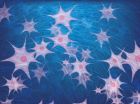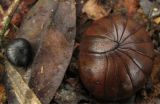(Press-News.org) When stem cells are used to regenerate bone tissue, many wind up migrating away from the repair site, which disrupts the healing process. But a technique employed by a University of Rochester research team keeps the stem cells in place, resulting in faster and better tissue regeneration. The key, as explained in a paper published in Acta Biomaterialia, is encasing the stem cells in polymers that attract water and disappear when their work is done.
The technique is similar to what has already been used to repair other types of tissue, including cartilage, but had never been tried on bone.
"Our success opens the door for many—and more complicated—types of bone repair," said Assistant Professor of Biomedical Engineering Danielle Benoit. "For example, we should now be able to pinpoint repairs within the periosteum—or outer membrane of bone material."
The polymers used by Benoit and her teams are called hydrogels because they hold water, which is necessary to keep the stem cells alive. The hydrogels, which mimic the natural tissues of the body, are specially designed to have an additional feature that's vital to the repair process; they degrade and disappear before the body interprets them as foreign bodies and begins a defense response that could compromise the healing process.
Because stem cells have the unique ability to develop into many different types of cells, they are an important part of the mechanism for repairing body tissue. At present, unadulterated therapeutic stem cells are injected into the bone tissue that needs to be repaired. Benoit believed hydrogels would allow the stem cells to finish the job of initiating repairs, then leave before overstaying their welcome.
The research team tested the hypothesis by transplanting cells onto the surface of mouse bone grafts and studying the cell behavior both in vivo—inside the animal—and in vitro—outside the body. They started by removing all living cells from donor bone fragments, so that the tissue regeneration could be accomplished only by the stem cells.
In order to track the progress of the research, the stem cells were genetically modified to include genes that give off fluorescence signals. The bone material was then coated with the hydrogels, which contained the fluorescently labeled stem cells, and implanted into the defect of the damaged mouse bone. At that point, the researchers began monitoring the repair process with longitudinal fluorescence to determine if there would be an appreciable loss of stem cells in the in vivo samples, as compared to the static, in vitro, environments. They found that there was no measurable difference between the concentrations of stem cells in the various samples, despite the fact that the in vivo sample was part of a dynamic environment—which included enzymes and blood flow—making it easier for the stem cells to migrate away from the target site. That means virtually all the stem cells stayed in place to complete their work in generating new bone tissue.
"Some types of tissue repair take more time to heal than do others," said Benoit. "What we needed was a way to control how long the hydrogels remained at the site."
Benoit and her team were able to manipulate the time it took for hydrogels to dissolve by modifying groups of atoms—called degradable groups—within the polymer molecules. By introducing different degradable groups to the polymer chains, the researchers were able to alter how long it took for the hydrogels to degrade.
Benoit believes degradable hydrogels show promise in many research areas. For example, it may be possible to initiate tissue regeneration after heart attacks without having a patient undergo difficult, invasive surgery, but a great deal of additional research is required.
INFORMATION:
Funding for Benoit's research was provided by the National Institutes of Health (NIH), the Orthopaedic Research and Education Foundation/Musculoskeletal Transplant Foundation, and the Rochester/Finger Lakes Eye & Tissue Bank.
Better tissue healing with disappearing hydrogels
2014-06-06
ELSE PRESS RELEASES FROM THIS DATE:
Lower asthma risk is associated with microbes in infants' homes
2014-06-06
Infants exposed to a diverse range of bacterial species in house dust during the first year of life appear to be less likely to develop asthma in early childhood, according to a new study published online on June 6, 2014, in the Journal of Allergy and Clinical Immunology.
Children who were neither allergic nor prone to wheezing as three-year-olds were the most likely to have been exposed to high levels of bacteria, and paradoxically, to high levels of common allergens.
In fact, some of the protective bacteria are abundant in cockroaches and mice, the source of these ...
NASA and NOAA satellites eyeing Mexico's tropical soaker for development
2014-06-06
NASA and NOAA satellites are gathering visible, infrared, microwave and radar data on a persistent tropical low pressure area in the southwestern Bay of Campeche. System 90L now has a 50 percent chance for development, according to the National Hurricane Center and continues to drop large amounts of rainfall over southeastern Mexico.
The Atmospheric Infrared Sounder (AIRS) instrument aboard NASA's Aqua satellite gathered infrared data on the developing low on June 5 at 18:59 UTC (2:59 p.m. EDT).
Basically, AIRS looks at the infrared region of the spectrum. In a spectrum, ...
Study shows health policy researchers lack confidence in social media for communication
2014-06-06
Philadelphia – Though Twitter boats 645 million users across the world, only 14 percent of health policy researchers reported using Twitter – and approximately 20 percent used blogs and Facebook – to communicate their research findings over the past year, according to a new study from the Perelman School of Medicine at the University of Pennsylvania. In contrast, sixty-five percent used traditional media channels, such as press releases or media interviews. While participants believed that social media can be an effective way to communicate research findings, many lacked ...
Evolution of a bimetallic nanocatalyst
2014-06-06
Atomic-scale snapshots of a bimetallic nanoparticle catalyst in action have provided insights that could help improve the industrial process by which fuels and chemicals are synthesized from natural gas, coal or plant biomass. A multi-national lab collaboration led by researchers with the U.S. Department of Energy (DOE)'s Lawrence Berkeley National Laboratory (Berkeley Lab) has taken the most detailed look ever at the evolution of platinum/cobalt bimetallic nanoparticles during reactions in oxygen and hydrogen gases.
"Using in situ aberration-corrected transmission electron ...
Tougher penalties credited for fewer casualties among young male drivers
2014-06-06
VIDEO:
A new Western University study led by Dr. Evelyn Vingilis has found a significant decline in speeding-related fatalities and injuries among young men in Ontario since the province's tough extreme...
Click here for more information.
A new study out of Western University (London, Canada) has found a significant decline in speeding-related fatalities and injuries among young men in Ontario since the province's tough extreme speeding and aggressive driving laws were introduced ...
Endoscope with an oxygen sensor detects pancreatic cancer
2014-06-06
JACKSONVILLE, Fla. — June 6, 3014 — An optical blood oxygen sensor attached to an endoscope is able to identify pancreatic cancer in patients via a simple lendoscopic procedure, according to researchers at Mayo Clinic in Florida.
The study, published in GIE: Gastrointestinal Endoscopy, shows that the device, which acts like the well-known clothespin-type finger clip used to measure blood oxygen in patients, has a sensitivity of 92 percent and a specificity of 86 percent.
MULTIMEDIA ALERT: Video and audio are available for download on the Mayo Clinic News Network.
That ...
Magnetic moment of the proton measured with unprecedented precision
2014-06-06
One of the biggest riddles in physics is the apparent imbalance between matter and antimatter in our universe. To date, there is no explanation as to why matter and antimatter failed to completely annihilate one another immediately after the big bang and how the surplus matter was created that went on to form the universe as we know it. Experiments conducted at Johannes Gutenberg University Mainz (JGU) have contributed towards a resolution of this problem. For the first time a direct and high-precision measurement of the magnetic moment of the proton has been conducted ...
A new way to make laser-like beams using 250x less power
2014-06-06
ANN ARBOR – With precarious particles called polaritons that straddle the worlds of light and matter, University of Michigan researchers have demonstrated a new, practical and potentially more efficient way to make a coherent laser-like beam.
They have made what's believed to be the first polariton laser that is fueled by electrical current as opposed to light, and also works at room temperature, rather than way below zero.
Those attributes make the device the most real-world ready of the handful of polariton lasers ever developed. It represents a milestone like none ...
New species of ancient chirping giant pill-millipedes from Madagascar already threatened
2014-06-06
An international team of researchers comprised of Thomas Wesener, Museum Koenig, Bonn, Daniel Le, Field Museum, Chicago and Stephanie Loria, American Museum of Natural History, New York, discovered seven new species of chirping giant pill-millipedes on Madagascar. The study was published in the open access journal ZooKeys.
The species discovered all belong to the genus Sphaeromimus, which is Latin for 'small ball animal'. However, the designation 'small' is not always true for the members of the genus as one of the newly discovered species surprises with a size larger ...
Probiotics prevent deadly complications of liver disease
2014-06-06
Bethesda, MD (June 6, 2014) — Probiotics are effective in preventing hepatic encephalopathy in patients with cirrhosis of the liver, according to a new study in Clinical Gastroenterology and Hepatology, the official clinical practice journal of the American Gastroenterological Association. Hepatic encephalopathy is a deterioration of brain function that is a serious complication of liver disease.
"This rigorous new research finds that probiotics modify the gut microbiota to prevent hepatic encephalopathy in patients with cirrhosis of the liver," said David W. Victor III, ...





